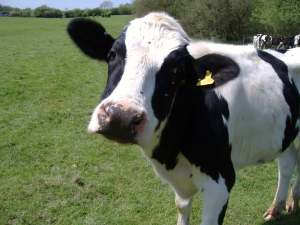So, I’m writing for EHow.com now, and this is one of the better ones I’ve written lately. Pretty cool stuff.
The Process
Strictly speaking, the animals on a farm are the methane generators, since it is the breakdown of their waste that produces this gas used to generate electricity. Well-established farm technologies, combined with a groundswell of interest in innovative energy sources, have led to the development of several systems that can harness the passive power of escaping gases.
Anaerobic decomposition, or bacteria breaking down materials in the absence of oxygen, generates volumes of methane. Historically, these and other waste gases have been allowed to merely evaporate into the atmosphere. But by collecting animal waste into covered lagoons and gathering the resulting gas, the waste can fuel a heat-powered electric generator. Excess energy not used for farming purposes can be sold to the local electric utility company and distributed out to the electric grid.
One Lancaster, Pa. farm, which recently completed a methane collection system, houses 1,400 head of dairy cattle and 250,000 broiler chickens. By converting collected gases, the farm produces 4 to 5 megawatts of electricity every day, most of which is sold back to the grid. This amount of electricity can power up to 200 homes per day.
How it Works
Barns are outfitted with flush tanks, which collect animal waste, which is then flushed to collecting tanks in a buried or covered pit, known as a lagoon. The lagoon complex usually includes one or more overflow pits per lagoon; this helps keep lagoon volumes and rates of gas production consistent. Waste breaks down best at temperatures between 40 and 90 degrees Fahrenheit, so concrete-lined pits in colder areas may be equipped with insulation and heaters to keep the temperature consistent throughout the year.
Bacteria present in the animal waste begins to break down the solids, releasing carbon dioxide, methane and hydrogen sulfide, known collectively as biogas. An alternate design, called a plug-flow system, has concrete tanks with an agitator, which prevents solids from crusting and evenly distributes solids for uniform decomposition.
Waste gases are collected through an outlet tube at the top of the tank and are then fed into a generator system. Most engines generate power by burning the methane via internal combustion, which produces electricity. Since the hydrogen sulfide gas byproduct is corrosive to combustion engines, it is removed either through microbial pit filters or scrubbers in the generating plant.
Once biogases are removed, the remaining solids either continue to accumulate for later removal or are piped out and dried for use as fertilizer. Many of the leftover solids consist of nitrogen, phosphorous, copper and zinc, and with minimal treatment may be spread over cropland as a fertilizer.
Costs
Costs for installing a biogas collection and combustion system can be prohibitively high for small farms, which take much longer to recoup the costs than a larger farm. The National Sustainable Agriculture Information Service, which operates on a grant by the US Department of Agriculture, estimates that a 150-head pig farm might build an anaerobic methane generator system for $25,000, though a 5,000-head dairy farm system could cost upward of $1.3 million. Depending on the amount of electricity generated and sell-back rates, these systems can take three to seven years or more to realize a profit.
The US Environmental Protection Agency, in conjunction with other federal and state agencies, provides grants and other financial assistance for farmers interested in building a methane collection and electricity generation system.
Concerns
Methane and hydrogen sulfide are also poisonous gases, and in sufficient quantities can kill a human by asphyxiation in only seconds. Should the gas collection system somehow rupture, these gases are more or less safe as long as they disperse into the air. However, if a system failure requires maintenance in a closed, confined space, workers must observe proper safety measures, including use of a self-contained breathing apparatus (SCBA).
Reference Links:
- North Carolina State University: Biogas Anaerobic Digester Considerations
- EPA Methane Recovery Workshop Summary
- Oregon.gov: Biomass Energy
Additional Resources:
- US Senate Agriculture Committee: Testimony of Luke Brubaker
- Anaerobic Digestion of Animal Wastes: Factors to Consider
- Cornell University: Hydrogen Sulfide Safety Fact Sheet
Article URL:
http://www.ehow.com/how-does_5839767_methane-generators-used-farms-work.html

